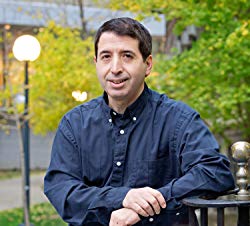After an 18-month delay, the world’s largest atom smasher, the Large Hadron Collider, is finally producing results. Located near Geneva, Switzerland, the $10-billion collider is designed to smash protons into each other at a smidgeon less than the speed of light, in the hope of glimpsing some of the secrets of the early universe.
The first step, says U of T physicist Richard Teuscher, is to “rediscover” the Standard Model, the current theory of subatomic particles and their interactions. For example, one of the collider’s detectors, known as ATLAS, has already observed a particle known as the W-boson, first detected more than 25 years ago. That observation “was worth a Nobel Prize in the 1980s,” says Teuscher. “Today it is a crucial observation proving that the ATLAS detector is functioning as expected.”
A number of U of T researchers, including Teuscher, are involved with the Large Hadron Collider, and with the ATLAS detector in particular.
Teuscher and his wife celebrated with champagne when the collider produced its first collisions on March 30. The previous try didn’t go so well; in September 2008, the first attempt to start up the collider ended with an explosion that damaged part of the LHC’s tunnel and destroyed some of the device’s powerful magnets.
But this time, everything worked as planned. For now the collider is operating at an energy of 7 million electron-volts, or about half of the 14 MeV the scientists are ultimately aiming for; when they get to that level, in perhaps three years’ time, they’ll be mimicking the conditions that prevailed in the first moments after the big bang. The current “run” will last until the end of 2011, Teuscher says, and will yield enough data to keep everyone busy for the next couple of years, before the collider is ramped up to higher energy.
As I reported in the Winter 2008 issue, data from the LHC could help scientists discern the nature of “dark matter,” and may also offer a glimpse of an elusive particle known as the Higgs boson, the one missing piece in the Standard Model. It may even reveal signs that our universe contains hidden “extra dimensions,” along with the three space dimensions and one time dimension that we’re aware of, an idea that could lend support to string theory.
Recent Posts
U of T’s Feminist Sports Club Is Here to Bend the Rules
The group invites non-athletes to try their hand at games like dodgeball and basketball in a fun – and distinctly supportive – atmosphere
From Mental Health Studies to Michelin Guide
U of T Scarborough alum Ambica Jain’s unexpected path to restaurant success
A Blueprint for Global Prosperity
Researchers across U of T are banding together to help the United Nations meet its 17 sustainable development goals





